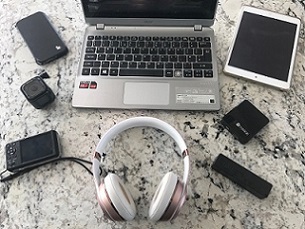 All these personal electronic devices are powered by lithium ion batteries
All these personal electronic devices are powered by lithium ion batteries
 The last place you'd want a fire is in the close confines of a passenger plane
The last place you'd want a fire is in the close confines of a passenger plane
 An AvSax battery fire containment bag now on board thousands of passenger planes worldwide
An AvSax battery fire containment bag now on board thousands of passenger planes worldwide
Two people were hurt when a passenger’s power bank used to charge electronic devices caught fire on a plane just moments before it was about to take off.
The Scoot flight was taxiing to the runway at Taipei Taoyuan International Airport about to leave for Singapore’s Changi Airport when the passenger’s power bank caught fire and erupted in flames.
The cabin quickly filled with smoke but the fire was tackled by the crew before the airport’s firefighters arrived.
The power bank’s owner and his travel companion suffered minor burns to their fingers. They did not need to go to hospital after the incident at 7.30pm on January 10.
In a video posted online, passengers could be seen wearing facemasks to try to avoid breathing in the smoke while two crew members brought the fire under control.
The plane returned to the gate and all the passengers disembarked but were unable to continue their journey until the following day.
An eyewitness on board told the CNA news agency passengers were clearly scared by the emergency but was just relieved it hadn’t happened a few minutes later after the plane had taken off.
Power banks and all electronic devices ranging from mobile phones to laptops are powered by lithium-ion batteries but there is always the danger they can overheat and go into what’s known as thermal runaway.
This happens when one cell in a battery overheats it can produce enough heat – up to 900°C (1652°F) – to cause adjacent cells to overheat. This can cause a lithium battery fire to flare repeatedly and they are then very difficult to put out due to their intensely high temperatures. They can even explode so these fires are the last thing you’d want to face in the confined space of a passenger aircraft.
Many airline operators now have special lithium battery fire containment bags on board and the best-selling one by far is the award-winning AvSax (www.avsax.com) which are now on more than 16,770 aircraft operated by over 100 airline companies worldwide.
They have been used 33 times to deal with emergencies since the start of 2017 and every time they have been deployed the aircraft has been able to complete its journey safely with no need to divert or make an emergency landing.
AvSax, invented by UK-based Environmental Defence Systems, won the prestigious Queen’s Award for Enterprise in the UK in 2018, the highest award any business can get.
Many air ambulance helicopters in the UK now carry AvSax. More than 20 helicopters operated by specialist aerial emergency medical services company Babcock were equipped with AvSax following a detailed look into the possible risks posed by lithium-ion batteries on aircraft.
The danger posed by lithium batteries means they must always be carried in the cabin so the crew can deal with any fire should the worst happen.
They must never be in the luggage hold as automatic fire suppression systems could struggle to cope with a fire of such intensity. The batteries and devices would be surrounded by clothes and other combustible materials so any fire could quickly take hold.
Cabin crew now often warn people in the safety briefing to alert them immediately if they lose their phone or any other personal electronic device down their seats. This is because if they move their seat the mechanism could crush the battery, sparking a fire.